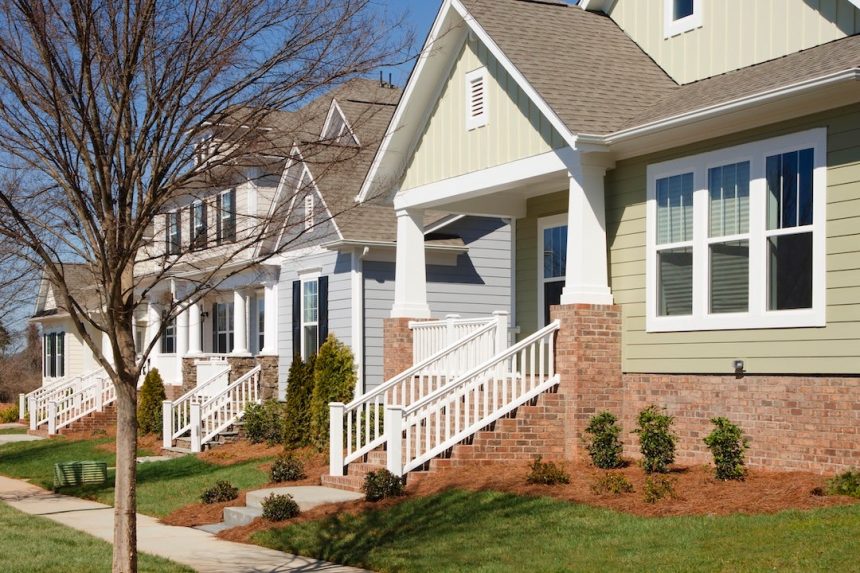Key takeaways
- The gap between prices of new-construction homes and existing homes has narrowed. On top of that, builder financing promotions are helping qualified buyers in specific regions.
- The increase in supply of new homes in the South and West has led to lower prices and more choices for buyers in those regions. On the flip side, the Northeast and Midwest have much less inventory of new homes.
- The recent tariffs imposed on imported goods have led to an increase in construction costs, adding approximately $10,900 to the price of a new home.
Some days it feels like the housing market is suffering from a hangover. The rush to increase supply has led to more new construction available. Meanwhile, the recent swing in mortgage rates has led to a lock-in effect with current homeowners, constraining the supply of existing homes. That means buying new is the more logical choice for a greater number of homebuyers.
If you’re thinking about buying a new-construction home, here’s what you need to know.
How new construction homes compare to existing homes in today’s market
New construction homes have always been pricier than existing homes. After all, you’re getting brand new everything. However, with the current market, the gap between new and existing home prices has narrowed.
The typical new home price in Q1 2025 was less than 4 percent higher than the price of an existing home, according to an analysis from the National Association of Home Builders (NAHB). In 2013, new homes cost 36 percent more than existing homes.
The change in the price difference between new and old homes is mostly due to inventory. Inventory of existing homes has stayed low in recent years, hitting 4.7 months of supply in June 2025, according to the National Association of Realtors (NAR). Meanwhile, new construction had 9.8 months of supply in the same month, according to the U.S. Census Bureau. As a result, the increased supply of newly built homes has helped drive more buyers toward new construction.
“Faced with the alternative of choosing between an existing home and a newly built home, 61 percent of home buyers in a recent NAHB study indicated a new home is their first preference,” says Danushka Nanayakkara-Skillington, assistant vice president of forecasting and analysis for the NAHB. “That marks the highest share of buyers leaning toward a new home since 2007.”
The market doesn’t look the same everywhere
Even with rising new home inventories, we’re still facing a national housing shortage. Still, some areas are better than others.
Inventory in the South and West has been growing with new construction. These regions have seen higher amounts of new home construction since 2023 when compared to the Northeast and the Midwest, according to the U.S. Census Bureau. This influx of new homes has led to more choices for buyers and some lower prices.
For instance, Florida and Texas had the two highest amount of active listings in June 2025, according to Realtor.com. The Miami metro saw a 4.7 percent median price drop compared to June 2024. Similarly, Austin saw a 4.5 percent drop in that timeframe. On the flip side, cities in the Northeast and the Midwest saw lower active listings and less price cuts than those in the South and the West.
Builders may offer lower rates, but demand is waning
Of course, this has also happened in an environment of higher mortgage rates. Homebuilders often have tools in their bag to make new homes more affordable for buyers. For instance, large builders sometimes also have a financing arm, which allows you to borrow from your builder. These lenders can offer special incentives, such as temporary rate buydown, for financing with a builder’s preferred lender.
What is a 2/1 buydown?
A 2/1 buydown is a common mortgage rate discount that lenders offer. In the first year of the loan, your rate is discounted by 2 percent. In the second year, it’s discounted by 1 percent. You don’t start paying your full rate until you’re three years into the loan.
Still, demand for new homes is down. When compared to June 2024, there were 6.6 percent fewer new home sales in June 2025, according to the U.S. Census Bureau. As buyers worry about economic uncertainty and rising home prices, many people are pausing their homebuying journeys.
Shop smarter for mortgage rates
Bankrate connects you to the latest lender offers, tailored to you. Find your low rate today.
Explore mortgage rates
Tariff impacts on construction costs and demand
Adding to those rising home prices is the rise of construction costs, due in part to tariffs imposed on importers by the Trump administration. According to the NAHB, 7 percent of all goods used in 2024 were imported. Builders estimate that recent tariff actions could add $10,900 to the price of a new home, says Nanayakkara-Skillington.
But tariffs are just a drop in the bucket when it comes to overall price inflation. The cost of building materials has risen by 34 percent since December 2020, says Nanayakkara-Skillington. This has outpaced inflation and income growth. In December 2020, the median new home price was $339,300, according to the U.S. Census Bureau. The median price peaked in October 2022 at $460,300. Since then, demand has dropped, due in large part to high interest rates.
There’s a possible scenario where tariffs bring down mortgage rates. This would be due to them driving down bond yields. Yet, this could increase inflation, leaving the market in the same place it’s been recently. If demand rises due to lower rates, it could trigger price increases, which, in turn, could trigger the Federal Reserve to raise rates.
Whether you’re buying a new or existing home, this moment can feel precarious.
When new construction makes sense
There are several scenarios where buying a new construction home makes sense. Let’s break down a few:
- When you want new: “The biggest upside of a new home is that it hasn’t suffered any wear. All the systems and components are new,” says Nick Gromicko, a certified master inspector and founder of the International Association of Certified Home Inspectors.
- When a new home is where you want it: In real estate, location is huge. If you’re looking in a specific area, and new homes are most of the inventory, it makes sense to buy new. After all, you’re also buying into a community, a school district and a tax code.
- When the existing housing stock is inadequate: In many areas, there aren’t a lot of existing homes, and the ones there may be in disrepair. If you have needs that existing inventory isn’t meeting, buying new may be the move.
- When it’s cheaper to buy new: New and existing home prices aren’t as different as they used to be. Put rate discounts on the table by financing with a builder, and you may find buying new comes with a lower monthly payment.
Pros and cons of buying new construction
Buying new construction comes with pluses and negatives. Weigh these pros and cons before considering a new house.
Pros
- They’re customizable: While homes are being built, you may be able to select things like paint, flooring and appliances.
- Buyer incentives: Many builders offer incentives to get buyers in a home, such as a lower interest rate or upgrades.
- Energy efficient: New homes may have better insulation and energy-saving appliances, which could save you money over time.
Cons
- Could be poorly built: Builders have an interest to build the home as quickly and cheaply as possible, says Gromicko. That’s the opposite of what a buyer wants.
- Higher cost: New homes have a higher median sales price than existing homes.
- You may have to wait: If you buy new, it takes time to build the home.
Tips for buying new in today’s market
If you’re buying a new home in today’s economy, you need to know you’re making a good investment. Most homebuyers get an inspection on a completed home, but Gromicko recommends at least two inspections for new homes.
“The more important inspection to perform is one before all the mechanical work is covered in drywall and paint,” says Gromicko. “This way, your inspector can see what is going on behind the walls before there are walls.”
Another aspect to consider is financing. Mortgage rates have seen some quick ups and downs this year. If possible, you want to capitalize on the dip. Bankrate’s new Mortgage Rate Variability Index can help you see when rates are shifting. With a higher variability, there’s great opportunity to shop around.
Why we ask for feedback
Your feedback helps us improve our content and services. It takes less than a minute to
complete.
Your responses are anonymous and will only be used for improving our website.
Help us improve our content
Read the full article here
















